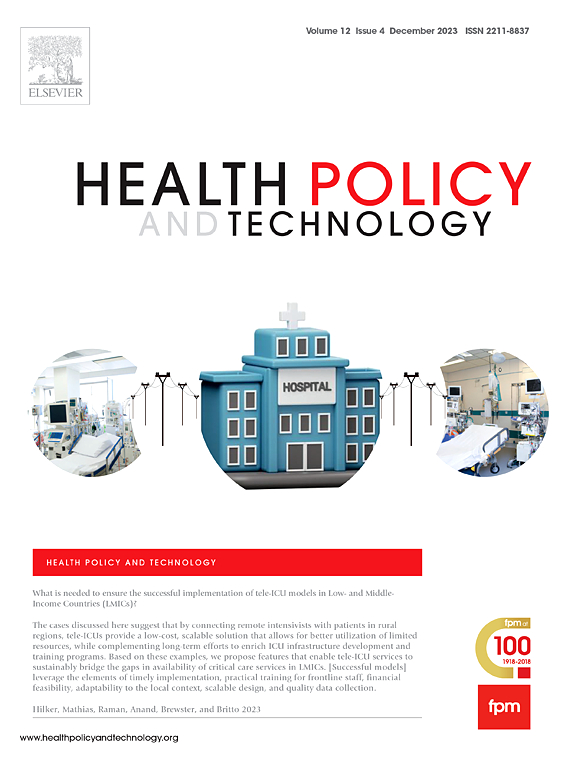Teleconsultation as a strategy to support primary health care professionals: A scoping review
IF 3.4
3区 医学
Q1 HEALTH POLICY & SERVICES
引用次数: 0
Abstract
Objectives
Map the evidence available in the literature and identify the best experiences regarding teleconsultation (TC) as a strategy to support clinical decisions in primary health care (PHC).
Methods
This is a scoping review guided by the structure proposed by Arksey & O'Malley and following the guidelines of the Joanna Briggs Institute (JBI) and The Preferred Reporting Items for Systematic Reviews and Meta-Analyses Extension for Scoping Reviews (PRISMA-ScR). The databases consulted were MEDLINE via PubMed, EMBASE, Cochrane Library, and LILACS via BVSalud without the restriction of language or date of publication.
Results
The search resulted in a total of 4,272 articles. Of these studies, 211 were included in the review. Publications included 21 countries from various health specialties. The countries with the highest number of publications were the United States (USA), Canada, and Brazil. The experiences showed that TC benefits healthcare systems by reducing the time of access to specialized care by patients treated in PHC, preventing unnecessary referrals to specialized care. The main barriers were inadequate responses to TC requests, infrastructure problems, difficulty incorporating the program into the organizational culture, and lack of management support. Cost reduction for the system and user satisfaction with TC were highlighted as the main strengths.
Conclusion
Teleconsultation successfully implemented rapid and effective communication between PHC physicians and secondary care specialists, potentially improving access and quality of care.
Public interest abstract
We explored how teleconsultation, a method where healthcare providers consult specialists remotely, can support PHC teams in making better decisions. Our research was motivated by the growing need to improve access to specialized care, especially in remote or underserved areas with long waiting times for specialists. By reviewing studies from various countries, we found that teleconsultation can reduce the time patients wait for specialist care, lower healthcare costs, and increase patient satisfaction. For example, teleconsultation has helped bridge the gap between PHC providers and specialists in countries like the USA, Canada, and Brazil, ensuring quicker, more effective care. However, challenges like poor infrastructure and lack of support from institution management and health managers remain. This support may include implementing clear policies, appropriate allocation of resources, and training for the healthcare team. By addressing these issues, teleconsultation can be a powerful tool to improve healthcare systems globally, making specialized care more accessible to everyone, regardless of where they live.
求助全文
约1分钟内获得全文
求助全文
来源期刊

Health Policy and Technology
Medicine-Health Policy
CiteScore
9.20
自引率
3.30%
发文量
78
审稿时长
88 days
期刊介绍:
Health Policy and Technology (HPT), is the official journal of the Fellowship of Postgraduate Medicine (FPM), a cross-disciplinary journal, which focuses on past, present and future health policy and the role of technology in clinical and non-clinical national and international health environments.
HPT provides a further excellent way for the FPM to continue to make important national and international contributions to development of policy and practice within medicine and related disciplines. The aim of HPT is to publish relevant, timely and accessible articles and commentaries to support policy-makers, health professionals, health technology providers, patient groups and academia interested in health policy and technology.
Topics covered by HPT will include:
- Health technology, including drug discovery, diagnostics, medicines, devices, therapeutic delivery and eHealth systems
- Cross-national comparisons on health policy using evidence-based approaches
- National studies on health policy to determine the outcomes of technology-driven initiatives
- Cross-border eHealth including health tourism
- The digital divide in mobility, access and affordability of healthcare
- Health technology assessment (HTA) methods and tools for evaluating the effectiveness of clinical and non-clinical health technologies
- Health and eHealth indicators and benchmarks (measure/metrics) for understanding the adoption and diffusion of health technologies
- Health and eHealth models and frameworks to support policy-makers and other stakeholders in decision-making
- Stakeholder engagement with health technologies (clinical and patient/citizen buy-in)
- Regulation and health economics
 求助内容:
求助内容: 应助结果提醒方式:
应助结果提醒方式:


